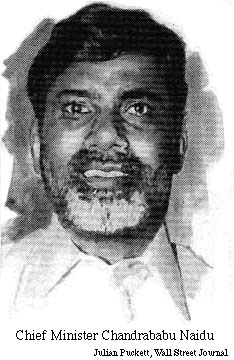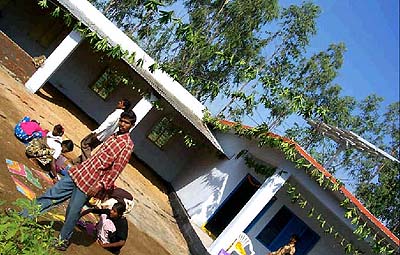|
with the Global Village Mr.N.Chandrababu Naidu at his offices in Hyderabad The Inauguration of Greenstar India. "I am extremely happy to participate in today's event, which aims to make available the rich cultural heritage of Parvatapur village over the Internet by Greenstar India. It is appropriate that this function is taking place to coincide with Mahatma Gandhi's birthday. Mahatma Gandhi always believed that since India lived largely in the villages, the economic and social development of villages was important for achieving true freedom.
The Internet is a great equaliser. It can allow even a remote village to reach out to the world. I think that that the approach adopted by Greenstar for bringing solar power, education, community health, satellite communications and electronic commerce services to rural villages is the best way to bridge the digital divide. The Internet is seeing a rapid growth within our country. We now have about 3.5 million Indians having access to the Net. I am sure that with increasing connectivity more and more Indians will begin to have access to the enormous reservoir of knowledge and information over the Internet. We are in the process of using satellite communications for providing information access to the villages. We hope to use the existing Ku band facilities on INSAT 3B and on MEASAT 1 and 2 satellites for providing services like distance learning, telemedicine, e-government and ecommerce to citizens of the state. The Internet as it exists today is largely oriented towards the English language and western culture. There is every need therefore to ensure that different cultures and different languages also find a place over the Internet. I am sure that the efforts of Greenstar in trying to capture India's are and culture, music, legends, literature and history will help a better understanding and appreciation of India's rich past. The infrastructure that will be set up by Greenstar will also help villagers to participate in the new economy. I am convinced that network connectivity can add substantially to incomes of farmers and artisans residing in the villages. I am happy that Greenstar is focusing on clean energy. There is every need to exploit solar power for meeting the energy needs in our country. Too much dependence on thermal power is not only expensive but is also a threat to the environment. I believe that the future will see more and more decentralised and local power generation. I am therefore keen to see that the efforts of Greenstar succeed. Greenstar is one of the few companies focused primarily on bringing the benefits of information technology to rural areas. I take this opportunity to convey my best wishes for the success of the endeavours of Greenstar in connecting villages using innovative solutions. I would particularly like to compliment Dr.Charles F.Gay for his commitment to the cause of making technology available for the development of rural communities. As a former Director of the Department of Energy's National Renewable Energy Laboratory, he brings rich experience to the field. On behalf of the Government of Andhra Pradesh I not only welcome Greenstar, but also I would be happy to extend whatever support is necessary to make the experiment a success."
|
 Gandhiji always practised what
he preached. He himself decided to settle in a village. He chose
Segaon situated near Wardha. The village had a population of
600 and lacked amenities like a pucca road, a shop or a post
office. I am therefore happy that Greenstar has decided to mark
Mahatma Gandhi's birthday by integrating one of the villages
of the state with a larger global village.
Gandhiji always practised what
he preached. He himself decided to settle in a village. He chose
Segaon situated near Wardha. The village had a population of
600 and lacked amenities like a pucca road, a shop or a post
office. I am therefore happy that Greenstar has decided to mark
Mahatma Gandhi's birthday by integrating one of the villages
of the state with a larger global village.